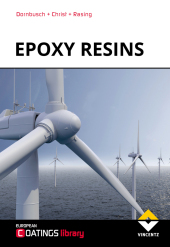 Neuerscheinungen 2016Stand: 2020-02-01 |
Schnellsuche
ISBN/Stichwort/Autor
|
Herderstraße 10
10625 Berlin
Tel.: 030 315 714 16
Fax 030 315 714 14
info@buchspektrum.de |

Ulrich Christ, Michael Dornbusch, Rob Rasing
(Beteiligte)
Epoxy Resins
2016. 240 p. w. figs. and tabs. 23 cm
Verlag/Jahr: VINCENTZ NETWORK 2016
ISBN: 3-86630-887-6 (3866308876)
Neue ISBN: 978-3-86630-887-9 (9783866308879)
Preis und Lieferzeit: Bitte klicken
Aufbau, Struktur und Eigenschaften der Epoxidharze werden für lösemittelhaltige als auch für wässrige Systeme in dem neuen Fachbuch Epoxidharze dargestellt. Die 1K- und die 2K-Systeme werden beleuchtet und die lacktechnischen Grundlagen effizient hervorgehoben. Dem Leser werden unterschiedliche Anwendungsmöglichkeiten der Epoxidharzsysteme und deren Vor- und Nachteile nahegebracht. Außerdem verschafft das Buch einen Einblick in anwendungstechnische Anforderungen und deren Überprüfung.
Content
1 Introduction, Michael Dornbusch
1.1 History
1.2 Application of epoxide resins
1.2.1 Coating agents
1.2.2 Construction materials
1.2.3 Adhesions
1.3 Terms and market
1.3.1 Nomenclature
1.3.2 Markets
1.4 Literature
2 Basic chemistry of the epoxy group, Michael Dornbusch
2.1 Properties and reactions of epoxy groups
2.1.1 Reaction with nucleophils
2.1.2 Reaction via acid catalyst
2.1.3 Properties of the epoxy group
2.2 Production and properties of epoxide resins
2.2.1 Production and properties of the monomers
2.2.1.1 Epichlorohydrin
2.2.1.2 Bisphenols
2.2.1.3 Epoxides based on olefins
2.2.1.4 Glycidyl ester
2.2.1.5 Aliphatic glycidyl ether
2.2.2 Production and propterties of the oligomers
2.2.2.1 Bisphenol based epoxide resins
2.2.2.2 Epoxide-novolaks
2.3 Parameters of epoxide resins
2.3.1 Epoxy equivalent of epoxy resins
2.3.2 OH-Number of epoxy resins
2.3.3 Chloride contents of epoxide resins
2.3.4 Investigation of the tendency to granulate of liquid resins
2.3.5 Detection reactions
2.4 Structure and properties of polymers based on epoxide resins and their curing
processes
2.4.1 Polyether polyol and phenoxy resins
2.4.2 Polyether polyol with epoxy groups
2.4.2.1 Catalytic curing of epoxide resins
2.4.3 Water based epoxide resins
2.4.4 Resins for hybrids with polymers based on epoxide resins
2.4.4.1 Epoxide acrylate
2.4.4.2 Epoxide alkyd, epoxyester
2.4.4.3 Epoxide-siloxane/silicone
2.4.4.4 Epoxide-polyamidimide
2.5 Literature
3 Epoxide in coatings
3.1 Epoxy groups as cross-linked building blocks, Michael Dornbusch
3.1.1 Overview of epoxy resins and hardeners
3.1.2 Epoxy groups in UV-curable coating systems
3.1.3 Epoxy groups in dip coatings
3.2 Protective coatings, Ulrich Christ
3.2.1 Industrial coatings
3.2.2 Corrosion protection
3.3 Applied flooring technology, Rob Rasing
3.3.1 Concrete
3.3.2 Application of epoxy thermosets for ambient cure condition
3.3.3 Floor design and installation
3.3.4 Industrial flooring performance attributes
3.3.5 High performance industrial flooring
3.4 Powder coatings, Ulrich Christ
3.4.1 Epoxy powder coatings
3.4.1.1 Curing with dicyandiamide (DICY)
3.4.1.2 Curing with phenolic resins
3.4.1.3 Curing with anhydrides
3.4.2 Epoxy polyester powder coatings or hybrid powder coatings
3.4.3 Polyester powder coatings
3.4.4 Acrylic powder coatings
3.5 Can and Coil Coatings, Michael Dornbusch
3.5.1 Can Coatings
3.5.2 Coil Coating
3.6 Literature
4 Trends and outlook, Ulrich Christ
4.1 Legal requirements related to health, safety and environmental protection
4.2 New product developments
4.2.1 Epoxy resins - applicable in future also for topcoats
4.2.2 New waterbased 1pack-epoxy technology for high duty corrosion protection systems
4.2.3 Improving the corrosion protection of 2pack- epoxy coatings by active anti-corrosion and barrier pigments
4.2.4 Trends in epoxy-based powder coatings
4.3 Potential replacement of BPA in Can Coatings, Michael Dornbusch
4.3.1 BPA replacement with bisphenol derivates
4.3.2 BPA replacement with new epoxide compounds
4.3.3 BPA replacement with other resins
4.4 Epoxides as building blocks for use of anthropogenic carbon dioxide for chemical syntheses, Ulrich Christ
4.5 Outlook - a strong growth predicted for epoxy resins
4.6 Literature


